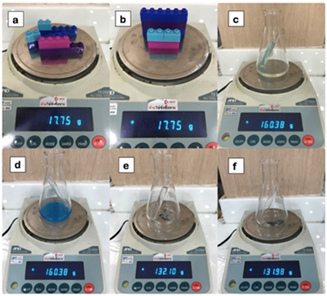กิจกรรมการเรียนรู้โดยใช้ตัวแทนความคิดทางวิทยาศาสตร์ที่หลากหลาย เพื่อส่งเสริมผลสัมฤทธิ์ทางการเรียน เรื่อง ปริมาณสารสัมพันธ์ สำหรับนักเรียนชั้นมัธยมศึกษาตอนปลาย
Main Article Content
บทคัดย่อ
งานวิจัยนี้มีวัตถุประสงค์เพื่อพัฒนากิจกรรมการเรียนรู้โดยใช้ตัวแทนความคิดทางวิทยาศาสตร์ที่หลากหลาย ส่งเสริมผลสัมฤทธิ์ทางการเรียนวิชาเคมี เรื่อง ปริมาณสารสัมพันธ์ และเปรียบเทียบผลสัมฤทธิ์ทางการเรียนระหว่างนักเรียนที่ได้รับการจัดกิจกรรมการเรียนรู้โดยใช้ตัวแทนความคิดทางวิทยาศาสตร์กับนักเรียนที่ได้รับการสอนแบบปกติ ประกอบด้วยเนื้อหา 5 เรื่อง ได้แก่ กฎทรงมวล กฎสัดส่วนคงที่ ปริมาตรของแก๊สในปฏิกิริยาเคมี ความสัมพันธ์ระหว่างปริมาณของสารในสมการเคมี และสารกำหนดปริมาณ กลุ่มตัวอย่างคือ นักเรียนชั้นมัธยมศึกษาปีที่ 5 จำนวน 60 คน ผ่านการเลือกแบบเจาะจง เครื่องมือที่ใช้ในการทดลอง ได้แก่ ใบกิจกรรม แบบสัมภาษณ์กึ่งโครงสร้าง และแบบทดสอบวัดผลสัมฤทธิ์ทางการเรียนวิชาเคมี เรื่อง ปริมาณสารสัมพันธ์ จากผลการวิจัยพบว่า ผลสัมฤทธิ์ทางการเรียนของนักเรียนที่ได้รับการจัดกิจกรรมการเรียนรู้โดยใช้ตัวแทนความคิดทางวิทยาศาสตร์ที่หลากหลาย เรื่อง ปริมาณสารสัมพันธ์ มีคะแนนหลังเรียนสูงกว่าก่อนเรียน อย่างมีนัยสำคัญทางสถิติ นอกจากนี้พบว่าผลสัมฤทธิ์ทางการเรียนของนักเรียนที่ได้รับการจัดกิจกรรมการเรียนรู้โดยใช้ตัวแทนความคิดทางวิทยาศาสตร์ที่หลากหลาย มีคะแนนสูงกว่านักเรียนที่ได้รับการจัดการเรียนรู้แบบปกติ อย่างมีนัยสำคัญที่ระดับ .05 โดยมีคะแนน 73.53± 3.91 และ 55.00±12.44 ตามลำดับ บ่งบอกได้ว่าการจัดกิจกรรมการเรียนรู้โดยใช้ตัวแทนความคิดทางวิทยาศาสตร์ที่หลากหลาย ช่วยส่งเสริมความเข้าใจมโนมติ เรื่อง ปริมาณสารสัมพันธ์ สำหรับนักเรียนได้
Article Details

อนุญาตภายใต้เงื่อนไข Creative Commons Attribution-NonCommercial-NoDerivatives 4.0 International License.
เอกสารอ้างอิง
ชฎาวรรณ สุขัมศรี มะยูโซ๊ะ กูโน และชัชฎาภรณ์ พิณทอง. (2561) การพัฒนาการจัดการเรียนรู้โดยใช้ตัวแทนความคิดทางวิทยาศาสตร์ เรื่อง ปริมาณสัมพันธ์ สำหรับนักเรียนชั้นมัธยมศึกษาตอนปลาย. วารสารครุศาสตร์อุตสาหกรรม, 17(3), 47-53.
ชูศรี วงศ์รัตนะ. (2550). เทคนิคการใช้สถิติเพื่อการวิจัย. พิมพ์ครั้งที่ 10. นนทบุรี : ไทยเนรมิตกิจอินเตอร์ โปรเกรสซิฟ.
ล้วน สายยศ และอังคณา สายยศ. (2539) เทคนิคการวัดผลการเรียนรู้. กรุงเทพฯ : ชมรมเด็ก.
Ainsworth, S. (2006). DeFT: A Conceptual Framework for Considering Learning with Multiple Representations. Learning and instruction, 16(3), 183-198.
Ben-Zvi, R., Eylon, B., & Silberstein, J. (1988). Theories, Principles and Laws. Education in Chemistry, 25(3), 89-92.
BouJaoude, S., & Barakat, H. (2000). Secondary School Students' Difficulties with Stoichiometry. School Science Review, 81(296), 91-98.
Bowen, C. W., & Bunce, D. M. (1997). Testing for Conceptual Understanding in General Chemistry. The Chemical Educator, 2(2), 1-17.
Camacho, M., & Good, R. (1989). Problem Solving and Chemical Equilibrium: Successful Versus Unsuccessful Performance. Journal of Research in Science Teaching, 26(3), 251-272.
Chang, R. (2008). General Chemistry: The Essential Concepts: Boston: McGraw-Hill.
Fach, M., de Boer, T. & Parchmann, I., (2007), Results of An Interview Study as Basis for The Development of Stepped Supporting Tools for Stoichiometric Problems. Chemistry Education Research and Practice, 8, 13-31.
Gilbert, J. K. (2008). Visualization: An Emergent Field of Practice and Enquiry in Science Education. In Visualization: Theory and Practice in Science Education (pp. 3-24): Springer.
Gilbert, J. K., & Treagust, D. F. (2009). Towards a Coherent Model for Macro, Submicro, And Symbolic Representations in Chemical Education. In Multiple representations in chemical education (pp. 333-350): Springer.
Haidar, A. H. (1997). Prospective Chemistry Teachers’ Conceptions of The Conservation of Matter and Related Concepts. Journal of Research in Science Teaching, 34, 181-197.
Hinton, M. E., & Nakhleh, M. B. (1999). Students’ Microscopic, Macroscopic, and Symbolic Representations of Chemical Reactions. The Chemical Educator, 4(5), 158-167.
Huddle, P., & Pillay, A. (1996). An in‐depth Study of Misconceptions in Stoichiometry and Chemical Equilibrium at a South African University. Journal of Research in Science Teaching: The Official Journal of the National Association for Research in Science Teaching, 33(1), 65-77.
Johnstone, A. H. 2000. Teaching of Chemistry: Logical or Psychological? Chemistry Education: Research and Practice in Europe, 1(1), 9–15.
Kozma, R. B., & Russell, J. (1997). Multimedia and Understanding: Expert and Novice Responses to Different Representations of Chemical Phenomena. Journal of research in science teaching, 34(9), 949-968.
Mammino, L. (2008). Teaching Chemistry with And Without External Representations in Professional Environments with Limited Resources. In Visualization: Theory and Practice in Science Education (pp. 155-185): Springer.
Özmen, H., Alipaşa, A., & Practice. (2003). Students’ difficulties In Understanding of The Conservation of Matter in Open and Closed-System Chemical Reactions. Chemistry Education Research Practice, 4(3), 279-290.
Staver, J. R., & Lumpe, A. T. (1995). Two Investigations of Students' Understanding of The Mole Concept and Its Use in Problem Solving. Journal of Research in Science Teaching, 32(2), 177-193.
Sunyono, Yuanita, L., & Ibrahim, M. (2015). Supporting Students in Learning with Multiple Representation to Improve Student Mental Models on Atomic Structure Concepts. Science Education International, 26(2).
Williamson, V. M., & Abraham, M. R. (1995). The Effects of Computer Animation on The Particulate Mental Models of College Chemistry Students. Journal of Research in Science Teaching, 32(5), 521-534.
Wu, H.-K., & Puntambekar, S. (2012). Pedagogical Affordances of Multiple External Representations in Scientific Processes. Journal of Science Education Technology, 21(6), 754-767.


